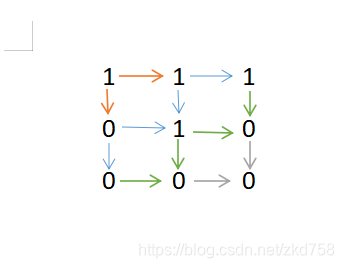Leetcode 542:01 矩阵 01 Matrix### 题目:
给定一个由 0 和 1 组成的矩阵,找出每个元素到最近的 0 的距离。
两个相邻元素间的距离为 1 。
Given a matrix consists of 0 and 1, find the distance of the nearest 0 for each cell.
The distance between two adjacent cells is 1.
示例 1:
输入:
0 0 0
0 1 0
0 0 0
输出:
0 0 0
0 1 0
0 0 0
示例 2:
输入:
0 0 0
0 1 0
1 1 1
输出:
0 0 0
0 1 0
1 2 1
注意:
- 给定矩阵的元素个数不超过 10000。
- 给定矩阵中至少有一个元素是 0。
- 矩阵中的元素只在四个方向上相邻: 上、下、左、右。
Note:
- The number of elements of the given matrix will not exceed 10,000.
- There are at least one 0 in the given matrix.
- The cells are adjacent in only four directions: up, down, left and right.
解题思路:
关键字:最近、距离。那肯定是广度优先搜索。类似之前的文章 岛屿数量: https://mp.weixin.qq.com/s/BrlMzXTtZWdB7hRfCKNMoQ
将这个问题转化成图,那就是求每个节点 1 到节点 0 最短的路径是多少。从某个节点开始,上下左右向外扩展,每次扩展一圈距离累加1,如:
输入:
1 1 1
0 1 0
0 0 0
转化成图(Graph),每种颜色代表一个层级:

这就变成了求某个节点到某个节点的深度了。
所以这道题有两种思路:
- 以节点1为根节点,求该节点到节点0之间的深度
- 以节点0为根节点,遇到最近的节点1路径计为1,再次以记录为1的节点为根节点继续向内遍历,遇到原节点1再次累加1并得到路径2,以此类推。。。
两种方法各有优劣,
以0节点为根节点解题,要么开辟一个新的二维数组以记录路径,要么先遍历一遍将所有的节点1的值改为不可能和路径大小重复的值。
以1节点为根节点,那么就要做一些多余的重复遍历。
以0为根节点:
逻辑顺序:
以输入下列二维数组为例:
1 1 1
0 1 1
0 0 1
先把原节点值为1 的节点改为M (路径值不可能达到的值,该题中大于10000即可)
先侵染0节点附近的M节点,0节点加1之后得到1节点
再侵染1节点附近的M节点,1节点加1之后得到2节点
......

Java:
class Solution {
public int[][] updateMatrix(int[][] matrix) {
int row = matrix.length, column = matrix[0].length;
int[][] neighbors = {{0, 1}, {0, -1}, {1, 0}, {-1, 0}};//邻居节点的索引偏移量
Queue<int[]> queue = new LinkedList<>();//队列
for (int i = 0; i < row; i++) {
for (int j = 0; j < column; j++) {
if (matrix[i][j] == 0) queue.offer(new int[]{i, j});
else matrix[i][j] = Integer.MAX_VALUE;//节点值为1的节点改为一个路径不可能达到的值
}
}
while (!queue.isEmpty()) {
int[] tmp = queue.poll();
for (int i = 0; i < 4; i++) {
//得到邻居节点索引
int x = tmp[0] + neighbors[i][0];
int y = tmp[1] + neighbors[i][1];
if (x >= 0 && x < row && y >= 0 && y < column && matrix[tmp[0]][tmp[1]] < matrix[x][y]) {
matrix[x][y] = matrix[tmp[0]][tmp[1]] + 1;//该节点的值得到邻居节点的路径值+1
queue.offer(new int[]{x, y});
}
}
}
return matrix;
}
}
Python3:
class Solution:
def updateMatrix(self, matrix: List[List[int]]) -> List[List[int]]:
row, column = len(matrix), len(matrix[0])
nerghbors = [(0, 1), (0, -1), (1, 0), (-1, 0)]
queue = collections.deque()
for i in range(row):
for j in range(column):
if matrix[i][j] == 0:
queue.append((i, j))
else:
matrix[i][j] = 10001
while queue:
x, y = queue.popleft()
for i, j in nerghbors:
xx = i + x
yy = j + y
if 0 <= xx < row and 0 <= yy < column and matrix[x][y] < matrix[xx][yy]:
matrix[xx][yy] = matrix[x][y] + 1
queue.append((xx, yy))
return matrix
以1为根节点:
Java:
class Solution {
public int[][] updateMatrix(int[][] matrix) {
int row = matrix.length, column = matrix[0].length;
for (int i = 0; i < row; i++)
for (int j = 0; j < column; j++)
if (matrix[i][j] == 1) matrix[i][j] = bfs(matrix, i, j, row, column);
return matrix;
}
private int bfs(int[][] matrix, int i, int j, int row, int column) {
int count = 0;
Queue<Integer> queue = new LinkedList<>();
Set<int[]> set = new HashSet<>();
queue.add(i * column + j);//记录索引的另一种方法
while (!queue.isEmpty()) {
int size = queue.size();
count += 1;
for (int k = 0; k < size; k++) {
int tmp = queue.poll();
int x = tmp / column, y = tmp % column;//得到索引坐标
//处理上下左右四个邻居节点,遇到0节点直接返回count路径值
if (x + 1 < row && !set.contains((x + 1) * column + y)) {
if (matrix[x + 1][y] != 0) queue.add((x + 1) * column + y);
else return count;
}
if (x - 1 >= 0 && !set.contains((x - 1) * column + y)) {
if (matrix[x - 1][y] != 0) queue.add((x - 1) * column + y);
else return count;
}
if (y + 1 < column && !set.contains(x * column + y + 1)) {
if (matrix[x][y + 1] != 0) queue.add(x * column + y + 1);
else return count;
}
if (y - 1 >= 0 && !set.contains(x * column + y - 1)) {
if (matrix[x][y - 1] != 0) queue.add(x * column + y - 1);
else return count;
}
}
}
return count;
}
}
Python3:
class Solution:
def updateMatrix(self, matrix: List[List[int]]) -> List[List[int]]:
row, column = len(matrix), len(matrix[0])
for i in range(row):
for j in range(column):
if matrix[i][j] == 1:
matrix[i][j] = self.bfs(i, j, matrix, row, column)
return matrix
def bfs(self, i: int, j: int, matrix: List[List[int]], row: int, column: int) -> int:
queue = collections.deque()
count = 0
nodeset = set()
queue.append((i, j))
while queue:
size = len(queue)
count += 1
for i in range(size):
x, y = queue.popleft()
if x + 1 < row and (x + 1, y) not in nodeset:
if matrix[x + 1][y] != 0:
queue.append((x + 1, y))
else:
return count
if x - 1 >= 0 and (x - 1, y) not in nodeset:
if matrix[x - 1][y] != 0:
queue.append((x - 1, y))
else:
return count
if y + 1 < column and (x, y + 1) not in nodeset:
if matrix[x][y + 1] != 0:
queue.append((x, y + 1))
else:
return count
if y - 1 >= 0 and (x, y - 1) not in nodeset:
if matrix[x][y - 1] != 0:
queue.append((x, y - 1))
else:
return count
return count
欢迎关注微.信公.众号:爱写Bug
